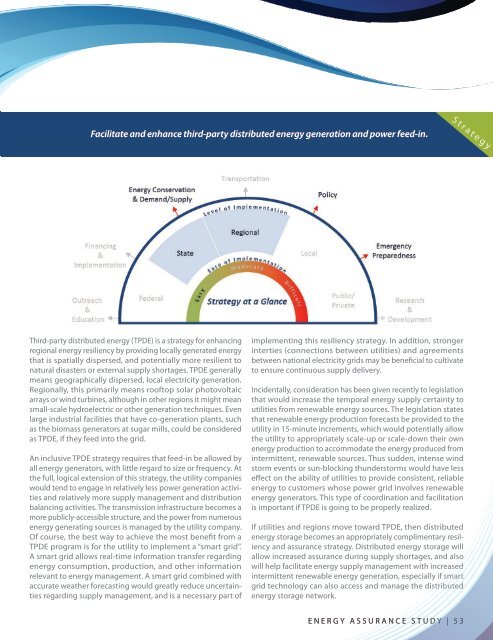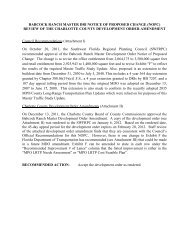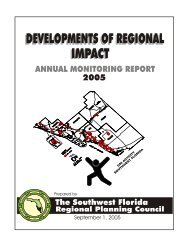Energy Assurance Study: Interim Report - Southwest Florida ...
Energy Assurance Study: Interim Report - Southwest Florida ...
Energy Assurance Study: Interim Report - Southwest Florida ...
- No tags were found...
Create successful ePaper yourself
Turn your PDF publications into a flip-book with our unique Google optimized e-Paper software.
StrategyFacilitate and enhance third-party distributed energy generation and power feed-in.Third-party distributed energy (TPDE) is a strategy for enhancingregional energy resiliency by providing locally generated energythat is spatially dispersed, and potentially more resilient tonatural disasters or external supply shortages. TPDE generallymeans geographically dispersed, local electricity generation.Regionally, this primarily means rooftop solar photovoltaicarrays or wind turbines, although in other regions it might meansmall-scale hydroelectric or other generation techniques. Evenlarge industrial facilities that have co-generation plants, suchas the biomass generators at sugar mills, could be consideredas TPDE, if they feed into the grid.An inclusive TPDE strategy requires that feed-in be allowed byall energy generators, with little regard to size or frequency. Atthe full, logical extension of this strategy, the utility companieswould tend to engage in relatively less power generation activitiesand relatively more supply management and distributionbalancing activities. The transmission infrastructure becomes amore publicly-accessible structure, and the power from numerousenergy generating sources is managed by the utility company.Of course, the best way to achieve the most benefit from aTPDE program is for the utility to implement a “smart grid”.A smart grid allows real-time information transfer regardingenergy consumption, production, and other informationrelevant to energy management. A smart grid combined withaccurate weather forecasting would greatly reduce uncertaintiesregarding supply management, and is a necessary part ofimplementing this resiliency strategy. In addition, strongerinterties (connections between utilities) and agreementsbetween national electricity grids may be beneficial to cultivateto ensure continuous supply delivery.Incidentally, consideration has been given recently to legislationthat would increase the temporal energy supply certainty toutilities from renewable energy sources. The legislation statesthat renewable energy production forecasts be provided to theutility in 15-minute increments, which would potentially allowthe utility to appropriately scale-up or scale-down their ownenergy production to accommodate the energy produced fromintermittent, renewable sources. Thus sudden, intense windstorm events or sun-blocking thunderstorms would have lesseffect on the ability of utilities to provide consistent, reliableenergy to customers whose power grid involves renewableenergy generators. This type of coordination and facilitationis important if TPDE is going to be properly realized.If utilities and regions move toward TPDE, then distributedenergy storage becomes an appropriately complimentary resiliencyand assurance strategy. Distributed energy storage willallow increased assurance during supply shortages, and alsowill help facilitate energy supply management with increasedintermittent renewable energy generation, especially if smartgrid technology can also access and manage the distributedenergy storage network.ENERGY ASSURANCE STUDY | 53









